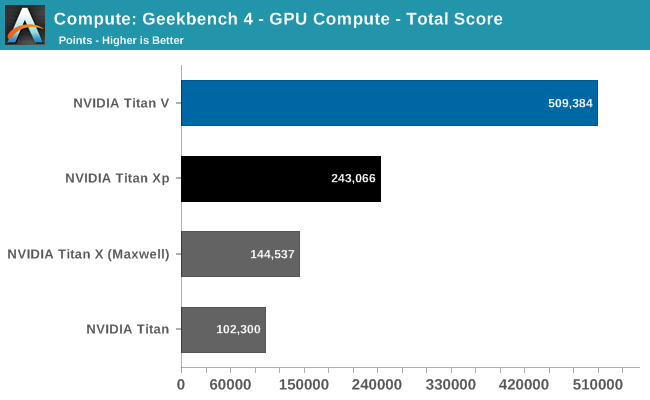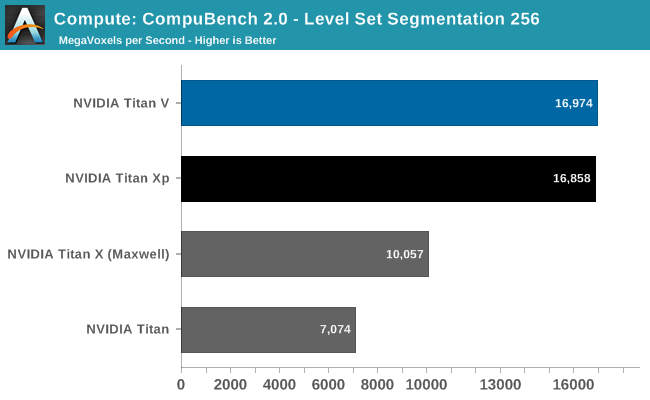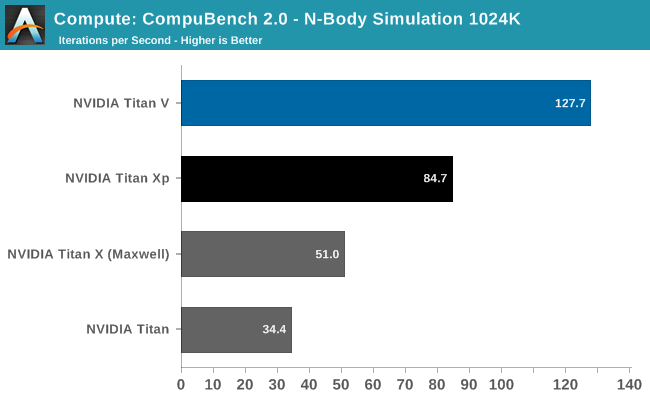The NVIDIA Titan V Preview - Titanomachy: War of the Titans
by Ryan Smith & Nate Oh on December 20, 2017 11:30 AM ESTCompute Performance: Geekbench 4
In the most recent version of its cross-platform Geekbench benchmark suite, Primate Labs added CUDA and OpenCL GPU benchmarks. This isn’t normally a test we turn to for GPUs, but for the Titan V launch it offers us another perspective on performance.

The results here are interesting. We’re not the only site to run Geekbench 4, and I’ve seen other sites with much different scores. But as we haven’t used this benchmark in great depth before, I’m hesitant to read too much into it. What it does show us, at any rate, is that the Titan V is well ahead of the Titan Xp here, more than doubling the latter’s score.
| NVIDIA Titan Cards GeekBench 4 Subscores | ||||||
| Titan V | Titan Xp | GTX Titan X | GTX Titan | |||
| Sobel (GigaPixels per second) |
35.1 | 24.9 | 16.5 | 9.4 | ||
| Histogram Equalization (GigaPixels per second) |
21.2 | 9.43 | 5.58 | 4.27 | ||
| SFFT (GFLOPS) |
180 | 136.5 | 83 | 60.3 | ||
| Gaussian Blur (GigaPixels per second) |
23.9 | 2.67 | 1.57 | 1.45 | ||
| Face Detection (Msubwindows per second) |
21.7 | 12.4 | 8.66 | 4.92 | ||
| RAW (GigaPixels per second) |
18.2 | 10.8 | 5.63 | 4.12 | ||
| Depth of Field (GigaPixels per second) |
3.31 | 2.74 | 1.35 | 0.72 | ||
| Particle Physics (FPS) |
83885 | 30344 | 18725 | 18178 | ||
Looking at the subscores, the Titan V handily outperforms the Titan Xp on all of the subtests. However it’s one test in particular that stands out here, and is likely responsible for the huge jump in the overall score, and that’s the Gaussian Blur, where the Titan V is 9x (!) faster than the Titan Xp. I am honestly not convinced that this isn’t a driver or benchmark bug of some sort, but it may very well be that Primate Labs has hit on a specific workload or scenario that sees some rather extreme benefits from the Volta architecture.
Folding @ Home
Up next we have the official Folding @ Home benchmark. Folding @ Home is the popular Stanford-backed research and distributed computing initiative that has work distributed to millions of volunteer computers over the internet, each of which is responsible for a tiny slice of a protein folding simulation. FAHBench can test both single precision and double precision floating point performance, giving us a good opportunity to let Titan V flex its FP64 muscles.

A CUDA-backed benchmark, this is the first sign that Titan V’s performance lead over the Titan Xp won’t be consistent. And more specifically that existing software and possibly even NVIDIA’s drivers aren’t well-tuned to take advantage of the Volta architecture just yet.
In this case the Titan V actually loses to the Titan Xp ever so slightly. The scores are close enough that this is within the usual 3% margin of error, which is to say that it’s a wash overall. But it goes to show that Titan V isn’t going to be an immediate win everywhere for existing software.
CompuBench
Our final set of compute benchmarks is another member of our standard compute benchmark suite: CompuBench 2.0, the latest iteration of Kishonti's GPU compute benchmark suite. CompuBench offers a wide array of different practical compute workloads, and we’ve decided to focus on level set segmentation, optical flow modeling, and N-Body physics simulations.



It’s interesting how the results here are all over the place. The Titan V shows a massive performance improvement in both N-Body simulations and Optical Flow, once again leading to the Titan V punching well above its weight. But then the Level Set Segmentation benchmark is practically tied with the Titan Xp. Suffice it to say that this puts the Titan V in a great light, and conversely makes one wonder how the Titan Xp was (apparently) so inefficient. The flip side is that it’s going to be a while until we fully understand why certain workloads seem to benefit more from Volta than other workloads.










111 Comments
View All Comments
mode_13h - Wednesday, December 27, 2017 - link
I don't know if you've heard of OpenCL, but there's not reason why a GPU needs to be programmed in a proprietary language.It's true that OpenCL has some minor issues with performance portability, but the main problem is Nvidia's stubborn refusal to support anything past version 1.2.
Anyway, lots of businesses know about vendor lock-in and would rather avoid it, so it sounds like you have some growing up to do if you don't understand that.
CiccioB - Monday, January 1, 2018 - link
Grow up.I repeat. None is wasting millions in using not certified, supported libraries. Let's avoid talking about entire frameworks.
If you think that researches with budgets of millions are nerds working in a garage with avoiding lock-in strategies as their first thought in the morning, well, grow up kid.
Nvidia provides the resources to allow them to exploit their expensive HW at the most of its potential reducing time and other associated costs. Also when upgrading the HW with a better one. That's what counts when investing millions for a job.
For you kid's home made AI joke, you can use whatever alpha library with zero support and certification. Others have already grown up.
mode_13h - Friday, January 5, 2018 - link
No kid here. I've shipped deep-learning based products to paying customers for a major corporation.I've no doubt you're some sort of Nvidia shill. Employee? Maybe you bought a bunch of their stock? Certainly sounds like you've drunk their kool aid.
Your line of reasoning reminds me of how people used to say businesses would never adopt Linux. Now, it overwhelmingly dominates cloud, embedded, and underpins the Android OS running on most of the world's handsets. Not to mention it's what most "researchers with budgets of millions" use.
tuxRoller - Wednesday, December 20, 2017 - link
"The integer units have now graduated their own set of dedicates cores within the GPU design, meaning that they can be used alongside the FP32 cores much more freely."Yay! Nvidia caught up to gcn 1.0!
Seriously, this goes to show how good the gcn arch was. It was probably too ambitious for its time as those old gpus have aged really well it took a long time for games to catch up.
CiccioB - Thursday, December 21, 2017 - link
<blockquote>Nvidia caught up to gcn 1.0!</blockquote>Yeah! It is known to the entire universe that it is nvidia that trails AMD performances.
Luckly they managed to get this Volta out in time before the bankruptcy.
tuxRoller - Wednesday, December 27, 2017 - link
I'm speaking about architecture not performance.CiccioB - Monday, January 1, 2018 - link
New bigger costier architectures with lower performance = failtuxRoller - Monday, January 1, 2018 - link
Ah, troll.CiccioB - Wednesday, December 20, 2017 - link
Useless cardVega = #poorvolta
StrangerGuy - Thursday, December 21, 2017 - link
AMD can pay me half their marketing budget and I will still do better than them...by doing exactly nothing. Their marketing is worse than being in a state of non-existence.